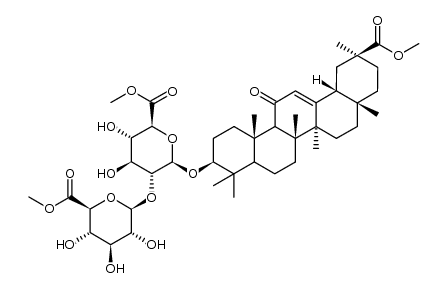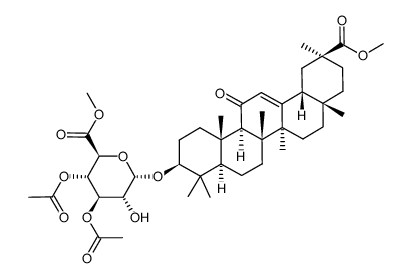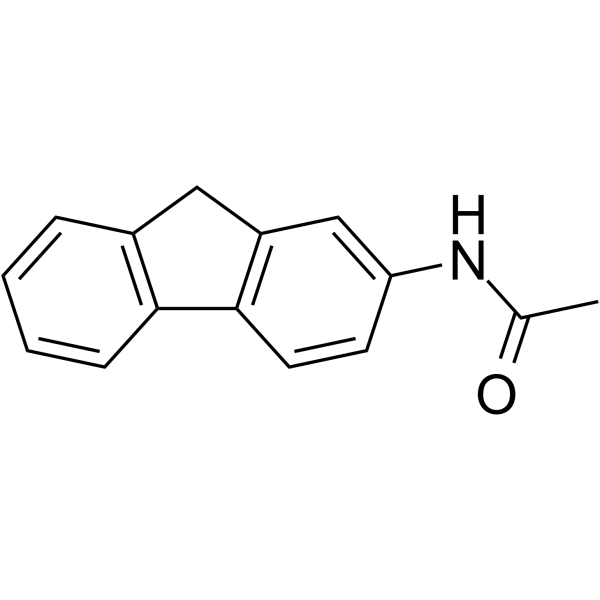1405-86-3
| 中文名 | 甘草酸 |
|---|---|
| 英文名 | glycyrrhizinic acid |
| 中文别名 |
强力宁
甘草皂苷 甘草甜素 甘草甜素 |
| 英文别名 |
Glycyrrhizin
Olean-12-en-30-oic acid, 3-[(2-O-β-D-glucopyranuronosyl-α-D-glucopyranuronosyl)oxy]-11-oxo-, (3β)- Potenlini Glycyrrhizate glycyron DerMacrin MFCD00167400 20b-Carboxy-11-oxo-30-norolean-12-en-3b-yl-2-O-b-D-glucopyranuronosyl-a-D-glucopyranosiduronic Acid (3β)-30-Hydroxy-11,30-dioxoolean-12-en-3-yl 2-O-β-D-glucopyranuronosyl-α-D-glucopyranosiduronic acid Glycyrrhizic acid Glycyrrhizine liquorice (3b,20b)-20-Carboxy-11-oxo-30-norolean-12-en-3-yl 2-O-b-D-Glucopyranuronosyl-a-D-glucopyranosiduronic Acid 30-Noroleanane, α-D-glucopyranosiduronic acid deriv glycyrrhizinic acid glycyrrhetinic acid glycoside Glycyrrhitin Glycyrrhizic EINECS 258-887-7 |
| 描述 | Glycyrrhizic acid 是甘草里面的活性成分三萜皂苷,为 HMGB1 的拮抗剂,具有抗肿瘤、抗糖尿病等功效。 |
|---|---|
| 相关类别 | |
| 体外研究 | 甘草酸具有一系列抗癌相关的药理活性,如广谱抗癌能力,化疗和放射引起的组织毒性抵抗,药物吸收增强作用和抗多药耐药(MDR)机制,如药物输送系统中的载体材料[1]。在分泌GLP-1的肠NCI-H716细胞中,甘草酸促进GLP-1分泌,钙水平显着升高。甘草酸可通过TGR5活化增强GLP-1的分泌[2]。 |
| 体内研究 | 在由链脲佐菌素(STZ处理的大鼠)诱导的1型糖尿病大鼠中,甘草酸增加血浆GLP-1的水平,其以足以抑制武田G蛋白偶联受体5(TGR5)的剂量被氨苯喋呤阻断。 [1]。甘草酸(Glycyrrhizic acid; 50 mg/kg,ip)显着降低小鼠的TgAb,HMGB1,TNF-α,IL-6,IL-1β水平[3]。 |
| 动物实验 | 将小鼠[3] NOD.H-2h4小鼠喂养在动物房中直至4周龄。然后将总共24只雄性小鼠随机分成三个不同的组(每组n = 8)。对照组小鼠给予无菌水,无需补充。碘补充剂(NaI)组中的小鼠在饮用水中给予0.005%NaI。 NaI +甘草酸组中的小鼠每天一次用50mg / kg甘草酸处理4周,在碘补充8周后通过腹膜内注射给药。在麻醉下通过外科手术取出甲状腺组织,用冷盐水洗涤,在滤纸上吸干并使用电子天平称重。然后将甲状腺组织储存在-80°C直至使用[3]。 |
| 参考文献 |
| 密度 | 1.4±0.1 g/cm3 |
|---|---|
| 沸点 | 971.4±65.0 °C at 760 mmHg |
| 熔点 | 220ºC decomposes |
| 分子式 | C42H62O16 |
| 分子量 | 822.932 |
| 闪点 | 288.1±27.8 °C |
| 精确质量 | 822.403809 |
| PSA | 267.04000 |
| LogP | 4.64 |
| 外观性状 | 晶体 |
| 蒸汽压 | 0.0±0.6 mmHg at 25°C |
| 折射率 | 1.621 |
| 储存条件 | 食品级塑料袋外套牛皮纸袋包装。贮存于阴凉干燥处。 |
| 稳定性 | 1. 如果遵照规格使用和储存则不会分解,未有已知危险反应,避免氧化物。 2. 存在于烟叶中。 3. 甘草根及根茎含三萜类化合物甘草甜素(Glycyrrhizin),主要为甘草酸的钾、钙盐,为甘草的甜味成分。甘草酸水解后产生两分子葡萄糖醛酸和一分子18β-甘草次酸(18β-Glycyrrhetic acid)。 |
| 水溶解性 | 易溶于:醇;不溶:乙醚 |
| 分子结构 | 1、摩尔折射率:201.36 2、摩尔体积(cm3/mol):572.6 3、等张比容(90.2K):1677.5 4、表面张力(dyne/cm):73.6 5、介电常数:无可用的 6、极化率(10-24cm3):79.82 7、单一同位素质量:822.403786 Da 8、标称质量:822 Da 9、平均质量:822.9321 Da |
| 计算化学 | 1、 疏水参数计算参考值(XlogP):3.7 2、 氢键供体数量:8 3、 氢键受体数量:16 4、 可旋转化学键数量:7 5、 互变异构体数量:5 6、 拓扑分子极性表面积(TPSA):267 7、 重原子数量:58 8、 表面电荷:0 9、 复杂度:1730 10、 同位素原子数量:0 11、 确定原子立构中心数量:19 12、 不确定原子立构中心数量:0 13、 确定化学键立构中心数量:0 14、 不确定化学键立构中心数量:0 15、 共价键单元数量:1 |
| 更多 | 1. 性状:白色结晶性粉末,甜度约为蔗糖的200倍。显甜迟后,但留甜时间长。 2. 熔点(ºC):212-217 3. 沸点(ºC,常压):972 4. 闪点(ºC): 288 5. 溶解性:难溶于冷水,易溶于热水,不溶于油脂,其热水溶液冷却后呈黏稠冻胶状。溶于丙二醇。 6. 相对密度(d204) :1.43 |
|
Section 1. Chemical Product and Company Identification Glycyrrhizic Acid Common Name/ Trade Name Glycyrrhizic Acid Section 4. First Aid Measures Check for and remove any contact lenses. In case of contact, immediately flush eyes with plenty of water for at least
Eye Contact 15 minutes. Cold water may be used. Get medical attention if irritation occurs. Wash with soap and water. Cover the irritated skin with an emollient. Get medical attention if irritation develops. Skin Contact Cold water may be used. Serious Skin ContactNot available. If inhaled, remove to fresh air. If not breathing, give artificial respiration. If breathing is difficult, give oxygen. Get Inhalation medical attention. Not available. Serious Inhalation Do NOT induce vomiting unless directed to do so by medical personnel. Never give anything by mouth to an Ingestion unconscious person. Loosen tight clothing such as a collar, tie, belt or waistband. Get medical attention if symptoms appear. Not available. Serious Ingestion Section 5. Fire and Explosion Data Flammability of the Product May be combustible at high temperature. Auto-Ignition Temperature Not available. Not available. Flash Points Not available. Flammable Limits These products are carbon oxides (CO, CO2). Products of Combustion Fire Hazards in Presence of Slightly flammable to flammable in presence of heat. Various Substances Risks of explosion of the product in presence of mechanical impact: Not available. Explosion Hazards in Risks of explosion of the product in presence of static discharge: Not available. Presence of Various Substances SMALL FIRE: Use DRY chemical powder. Fire Fighting Media LARGE FIRE: Use water spray, fog or foam. Do not use water jet. and Instructions Not available. Special Remarks on Fire Hazards Not available. Special Remarks on Explosion Hazards Section 6. Accidental Release Measures Use appropriate tools to put the spilled solid in a convenient waste disposal container. Finish cleaning by spreading Small Spill water on the contaminated surface and dispose of according to local and regional authority requirements. Use a shovel to put the material into a convenient waste disposal container. Finish cleaning by spreading water on Large Spill the contaminated surface and allow to evacuate through the sanitary system. Glycyrrhizic Acid Section 7. Handling and Storage Keep away from heat. Keep away from sources of ignition. Empty containers pose a fire risk, evaporate the residue Precautions under a fume hood. Ground all equipment containing material. Do not ingest. Do not breathe dust. If ingested, seek medical advice immediately and show the container or the label. Keep away from incompatibles such as oxidizing agents. Keep container tightly closed. Keep container in a cool, well-ventilated area. Storage Section 8. Exposure Controls/Personal Protection Use process enclosures, local exhaust ventilation, or other engineering controls to keep airborne levels below Engineering Controls recommended exposure limits. If user operations generate dust, fume or mist, use ventilation to keep exposure to airborne contaminants below the exposure limit. Personal ProtectionSafety glasses. Lab coat. Dust respirator. Be sure to use an approved/certified respirator or equivalent. Gloves. Personal Protection in Case Splash goggles. Full suit. Dust respirator. Boots. Gloves. A self contained breathing apparatus should be used to avoid inhalation of the product. Suggested protective clothing might not be sufficient; consult a specialist BEFORE of a Large Spill handling this product. Not available. Exposure Limits Section 9. Physical and Chemical Properties Solid. (Crystals solid. Crystalline solid.)Not available. Physical state andO dor appearance Intensely sweet. Taste 822.94g/mole Molecular Weight Not available. Color Not available. pH (1% soln/water) Not available. Boiling Point 200°C (392°F) Melting Point Decomposition Temperature: 220 deg. C. Not available. Critical Temperature Not available. Specific Gravity Not applicable. Vapor Pressure Not available. Vapor Density Not available. Volatility Not available. Odor Threshold The product is more soluble in oil; log(oil/water) = 2.8 Water/Oil Dist. Coeff. Not available. Ionicity (in Water) See solubility in water. Dispersion Properties Easily soluble in hot water. Solubility Partially soluble in cold water. Freely soluble in alcohol. Very slightly soluble in diethyl ether. Glycyrrhizic Acid Section 10. Stability and Reactivity Data The product is stable. Stability Not available. Instability Temperature Conditions of Instability Excess heat, incompatible materials Incompatibility with various Reactive with oxidizing agents. substances Not available. Corrosivity Not available. Special Remarks on Reactivity Not available. Special Remarks on Corrosivity Will not occur. Polymerization Section 11. Toxicological Information Inhalation. Ingestion. Routes of Entry Acute oral toxicity (LD50): 4320 mg/kg [Mouse]. Toxicity to Animals Chronic Effects on Humans Not available. Other Toxic Effects onSlightly hazardous in case of skin contact (irritant), of ingestion, of inhalation. Humans Not available. Special Remarks on Toxicity to Animals May affect genetic material (mutagenic) Special Remarks on Chronic Effects on Humans Special Remarks on otherAcute Potential Health Effects: Toxic Effects on HumansSkin: May cause skin irritation. Eyes: May cause eye irritation. Inhalation: Ma y cause respiratory tract irritation. Ingestion: May affect behavior/central nervous system (convulsions, muscle weakness), respiration (respiratory stimulation). Chronic Potential Health Effects: Prolonged or repeated ingestion may affect behavior (symptoms similar to that of acute ingestion), urinary system/kidneys (Proteinuria, myoglobinuria, acute renal failure), metabolism (metabolic alkalosis), blood (change in serum compostion), immune system (decrease in immune response), endocrine system. Section 12. Ecological Information Not available. Ecotoxicity Not available. BOD5 and COD Products of Biodegradation Possibly hazardous short term degradation products are not likely. However, long term degradation products may arise. The product itself and its products of degradation are not toxic. Toxicity of the Products of Biodegradation Not available. Special Remarks on the Products of Biodegradation Glycyrrhizic Acid Section 13. Disposal Considerations Waste must be disposed of in accordance with federal, state and local environmental control Waste Disposal regulations. Section 14. Transport Information Not a DOT controlled material (United States). DO T Cl assi fi cati on Not applicable. Identification Not applicable. Special Provisions for Transport DO T (Pi ctograms) Section 15. Other Regulatory Information and Pictograms TSCA 8(b) inventory: Glycyrrhizic Acid Federal and State Regulations California prop. 65: This product contains the following ingredients for which the State of California has found to California cause cancer which would require a warning under the statute: No products were found. Proposition 65 Warnings California prop. 65: This product contains the following ingredients for which the State of California has found to cause birth defects which would require a warning under the statute: No products were found. Other RegulationsEINECS: This product is on the European Inventory of Existing Commercial Chemical Substances (EINECS No. 215-785-7). Canada: Listed on Canadian Domestic Substance List (DSL). China: Listed on National Inventory. Japan: Listed on National Inventory (ENCS). Korea: Listed on National Inventory (KECI). Philippines: Listed on National Inventory (PICCS). Australia: Listed on AICS. WHMIS (Canada) Not controlled under WHMIS (Canada). Other Classifications This product is not classified according Not applicable. DSCL (EEC) to the EU regulations. Health Hazard HMIS (U.S.A.)1 National Fire Protection 1 Flammability 1 Association (U.S.A.) Fire Hazard 1 0 Reactivity Health Reactivity0 Specific hazard Personal Protection E WHMIS (Canada) (Pictograms) DSCL (Europe) (Pictograms) Glycyrrhizic Acid TDG(Canada) (Pictograms) ADR (Europe) (Pictograms) Protective Equipment Gloves. Lab coat. Dust respirator. Be sure to use an approved/certified respirator or equivalent. SECTION 16 - ADDITIONAL INFORMATION N/A |
|
毒理学数据: 急性毒性:人体口经TDLo:280mg/kg/4W;小鼠口经LCLo:3gm/kg;小鼠腹经LCLo:2gm/kg;小鼠静脉LC:>300mg/kg 生态学数据: 对是水稍微有危害的不要让未稀释或大量的产品接触地下水、水道或者污水系统,若无政府许可,勿将材料排入周围环境。 CHEMICAL IDENTIFICATION
HEALTH HAZARD DATAACUTE TOXICITY DATA
MUTATION DATA
|
| 危害码 (欧洲) | Xi |
|---|---|
| 安全声明 (欧洲) | S22-S24/25 |
| 危险品运输编码 | NONH for all modes of transport |
| RTECS号 | MD2025000 |
| 海关编码 | 1211903600 |
| 上游产品 3 | |
|---|---|
| 下游产品 3 | |
| 海关编码 | 1211903600 |
|---|








